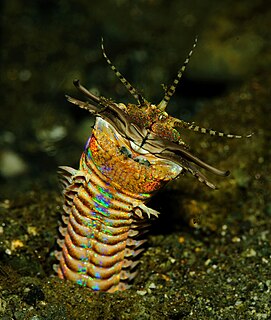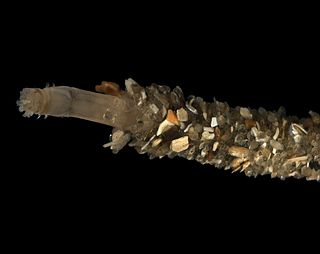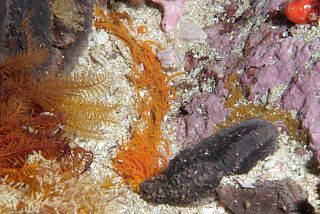
Alvinella pompejana, the Pompeii worm, is a species of deep-sea polychaete worm. It is an extremophile found only at hydrothermal vents in the Pacific Ocean, discovered in the early 1980s off the Galápagos Islands by French marine biologists.

Nereis is a genus of polychaete worms in the family Nereididae. It comprises many species, most of which are marine. Nereis possess setae and parapodia for locomotion. They may have two types of setae, which are found on the parapodia. Acicular setae provide support. Locomotor setae are for crawling, and are the bristles that are visible on the exterior of the Polychaeta. They are cylindrical in shape, found not only in sandy areas, and they are adapted to burrow. They often cling to seagrass (posidonia) or other grass on rocks and sometimes gather in large groups. They are dangerous to touch giving very painful long lasting burns. Nereis worms are commonly known as rag worms or clam worms. The body is long, slender, and dorso-ventrally flattened, reaching a length of 5-30 cm. The head consists of two parts: a roughly triangular anterior lobe—the prostomium—and a posterior ring-like portion—the peristomium. The latter bears a pair of terminal tentacles, dorsally two pairs of eyes, and ventrally a pair of short two-jointed palps.

The Terebellidae is a marine family of polychaete worms, of which the type taxon is Terebella, described by Carl Linnaeus in his 1767 12th edition of Systema Naturae.

Eunicidae is a family of marine polychaetes. The family comprises marine annelids distributed in diverse benthic habitats across Oceania, Europe, South America, North America, Asia and Africa. The Eunicid anatomy typically consists of a pair of appendages near the mouth (mandibles) and complex sets of muscular structures on the head (maxillae) in an eversible pharynx. One of the most conspicuous of the eunicids is the giant, dark-purple, iridescent "Bobbit worm", a bristle worm found at low tide under boulders on southern Australian shores. Its robust, muscular body can be as long as 2 m. Eunicidae jaws are known from as far back as Ordovician sediments. Cultural tradition surrounds Palola worm reproductive cycles in the South Pacific Islands. Eunicidae are economically valuable as bait in both recreational and commercial fishing. Commercial bait-farming of Eunicidae can have adverse ecological impacts. Bait-farming can deplete worm and associated fauna population numbers, damage local intertidal environments and introduce alien species to local aquatic ecosystems.
Psamathini are a tribe of phyllodocid "bristle worms" in the family Hesionidae. They are marine organisms; most are found on the continental shelf, but some have adapted to greater depths down to the abyssal plain.

Hesionidae are a family of phyllodocid "bristle worms". They are marine organisms. Most are found on the continental shelf; Hesiocaeca methanicola is found on methane ice, where it feeds on bacterial biofilms.
Acrocirridae is a family of polychaete worms. Acrocirrids are detritivores, catching falling particles with numerous long prostomial tentacles. There are eight known genera, and at least 21 described species and subspecies within the Acrocirridae. The acrocirrids are primarily benthic (seabed-dwelling) animals, but at least two genera appear to have evolved or adapted to a pelagic (free-swimming) habitat.

Phyllodoce is a genus of polychaete worms, which contains about 200 species. The prostomium bears eyes, two pairs of antennae and a pair of large retractile nuchal organs. The eversible proboscis is clearly divided into two parts.

Sabellastarte spectabilis is a species of benthic marine polychaete worm in the Sabellidae family. It is commonly known as the feather duster worm, feather duster or fan worm. It is native to tropical waters of the Indo-Pacific but has spread to other parts of the world. It is popular in aquariums because of its distinctive appearance and its ability to remove organic particles and improve water quality.

Errantia, occasionally Aciculata, is a subclass of polychaete worms. These worms are found worldwide in marine environments and brackish water.

Cirratulidae is a family of marine polychaete worms. Members of the family are found worldwide, mostly living in mud or rock crevices. Most are deposit feeders, but some graze on algae or are suspension feeders.
Diopatra is a genus of polychaete worms in the family Onuphidae.

Owenia is a genus of marine polychaete worms in the family Oweniidae.

Dodecaceria is a genus of marine polychaete worms in the family Cirratulidae.

Cirriformia is a genus of marine polychaete worms in the family Cirratulidae.
Acoetidae is a family of polychaete worms in the subclass Aciculata.

Phyllodocidae is a family of polychaete worms. Worms in this family live on the seabed and may burrow under the sediment.

Poecilochaetus is a genus of marine worms within the Polychaeta. It is the only genus in the monotypic family Poecilochaetidae. Members of this genus are benthic worms that burrow into soft sediments.
Subadyte pellucida is a scale worm widely reported from the Indian, Pacific and North Atlantic Oceans from the intertidal zone to depths of about 800 m.
Fabriciidae is a family of annelid worm in the class Polychaeta.













